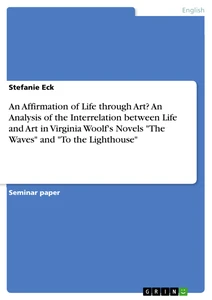 Yes, this is not a light-read and it isn’t for a beginner, but once you get hold of what’s being dealt with you’d fly through the literature.
Yes, this is not a light-read and it isn’t for a beginner, but once you get hold of what’s being dealt with you’d fly through the literature.
 Writing to a Rhythm, Not a Plot in Woolf's 'The Waves' Societal Standards and the Impact of the Individual in Virginia Woolf’s To the Lighthouse and The Waves
Writing to a Rhythm, Not a Plot in Woolf's 'The Waves' Societal Standards and the Impact of the Individual in Virginia Woolf’s To the Lighthouse and The Waves
 The Waves is Virginia Woolf's "play-poem", as she called it; a colloquy of six voices.
The Waves is Virginia Woolf's "play-poem", as she called it; a colloquy of six voices.
The Waves by Virginia Woolf Virginia Woolf’s The Waves, published on October 8, 1931, is considered one of her most experimental novels. By 1931 when the book hit stores, it had undergone a rather significant change from its manuscript form. Analysis of Virginia Woolf’s Novels By Nasrullah Mambrol on June 1, 2019 • ( 0). Episode 1: Louis, Bernard, Neville, Jinny, Susan, and Rhoda recall their childhood and first steps into adulthood. Essays for The Waves. This happens to be my first Virginia Woolf book, and I was certainly not disappointed. Explore Course Hero's library of literature materials, including documents and Q&A pairs. 1536 likes. The Waves Quotes Showing 1-30 of 337 “There was a star riding through clouds one night, & I said to the star, 'Consume me'.” ― Virginia Woolf, The Waves. From the appearance of her first novel in 1915, Virginia Woolf’s work was received with respect—an important point, since she was extremely sensitive to criticism. modernist. The Waves, by Virginia Woolf, is a novel published in 1931. By 1931 when the book hit stores, it had undergone a rather significant change from its manuscript form. Woolf's fluid, allusive stream-of-consciousness style can be heavy sledding on a normal day, and The Waves takes extra risks in experimenting with point-of-view, plot, and overall narration. The Waves - Section 4 Summary & Analysis Virginia Woolf This Study Guide consists of approximately 37 pages of chapter summaries, quotes, character analysis, themes, and more - everything you need to sharpen your knowledge of The Waves. It was written when Virginia Woolf was at the height of her experimental powers, and she allows each character to tell their own story, through powerful, poetic monologues. How much better to sit by myself like the solitary sea-bird that opens its wings on the stake. The Waves is a portrait of the intertwined lives of six friends: Bernard, Neville, Louis, Jinny, Susan, and Rhoda. Uniquely distinctive in the complexity of its construction and the highly abstracted approach to narrative, The Waves is often considered Virginia Woolf ’s masterpiece. The novel is divided into nine sections, each of which corresponds to a time of day, and, symbolically, to a period in the lives of the characters. During this phase of the novel, we learn a lot about the characters' personalities and their relationships to each other. by: Virginia Woolf. These papers were written primarily by students and provide critical analysis of The Waves. She also maintained an astonishing output of literary criticism, short fiction, journalism and biography, including the playfully subversive Orlando (1928) and A Room of One's Own (1929) a passionate feminist essay. The ‘story’ is told through ‘dramatic soliloquies’ [2] spoken by the six characters Rhoda, Jinny, Bernard, Susan, Neville and Louis. Instead of a plot-driven story, the stream-of-consciousness novel is told in a series of soliloquies by its many characters. The Waves is a novel by Virginia Woolf that was first published in 1931. This is … The Waves Summary The story begins by introducing us to the novel's six (yup, you read that right) narrators, Bernard, Neville, Louis, Jinny, Susan, and Rhoda, who meet as children in a nursery. 26 quotes have been tagged as the-waves: Virginia Woolf: ‘And in me too the wave rises.
 Yes, this is not a light-read and it isn’t for a beginner, but once you get hold of what’s being dealt with you’d fly through the literature.
Yes, this is not a light-read and it isn’t for a beginner, but once you get hold of what’s being dealt with you’d fly through the literature. Writing to a Rhythm, Not a Plot in Woolf's 'The Waves' Societal Standards and the Impact of the Individual in Virginia Woolf’s To the Lighthouse and The Waves
Writing to a Rhythm, Not a Plot in Woolf's 'The Waves' Societal Standards and the Impact of the Individual in Virginia Woolf’s To the Lighthouse and The Waves The Waves is Virginia Woolf's "play-poem", as she called it; a colloquy of six voices.
The Waves is Virginia Woolf's "play-poem", as she called it; a colloquy of six voices.